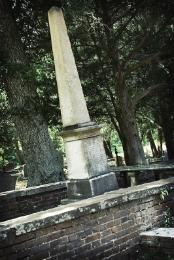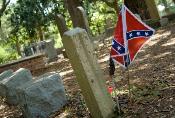

ExploreSouthernHistory.com - Old Smithville Burying Ground, North Carolina
ExploreSouthernHistory.com - Old Smithville Burying Ground, North Carolina

| Old Smithville Burying Ground The historic old cemetery dates back to before the American Revolution and has chronicled the passing of time on the lower Cape Fear River. |
Old Smithville Burying
GroundThe historic old
cemetery dates back to the
middle 1700s and preserves
the graves of soldiers of both
the American Revolution and
the Civil War.
GroundThe historic old
cemetery dates back to the
middle 1700s and preserves
the graves of soldiers of both
the American Revolution and
the Civil War.

Lest We Forget...
A small Confederate flag
flaps in the wind over the
grave of a Southern soldier.
A small Confederate flag
flaps in the wind over the
grave of a Southern soldier.


Shaded by the Oaks
The stones of the Old
Smithville Burying Ground tell
the story of life and death in
the Southport area for more
than 250 years.
The stones of the Old
Smithville Burying Ground tell
the story of life and death in
the Southport area for more
than 250 years.
Old Smithville Burying Ground - Southport, North Carolina
Resting Place of Heroes...

Shaded by beautiful oak trees, the historic
Old Smithville Burying Ground in Southport
chronicles the passage of time along North
Carolina's lower Cape Fear River.
In its fading stones and graves - both marked
and unmarked - can be read the history not
only of a city and a region, but of our nation
as well.
Not long after the English began building Fort
Johnston at present-day Southport in 1745, a
small community began to develop around
the military garrison near the mouth of the
Cape Fear River. Ships coming into the river
needed pilots and the protection of the fort
offered an ideal place for harbor pilots to
settle. They were joined there by traders and
others.
As is the case with all communities, the little
village at Fort Johnston needed a place to
bury its dead and it was not long before the
first graves were prepared at what is now the
Old Smithville Burying Ground. By the time
the community was designated the town of
Smithville in 1792, the little cemetery had
already been in existence for a number of
years.
Monuments in the cemetery honor some of
the most notable individuals in American
history, among them Governor Benjamin
Smith, for whom Smithville was named. Born
in surrounding Brunswick County in 1756,
Smith served valiantly in the American
Revolution. As a colonel, he fought under the
command of General George Washington
and by the time the war came to an end, his
name was inscribed with honor in the history
of his country.
Returning home to North Carolina, Smith
served in the state senate for 25 years before
his election as governor in 1810. He died in
Brunswick County, not far from where he was
born, in 1816 have lived long enough to see
the fledgling United States once again defeat
Great Britain in a military conflict, the War of
1812.
There is some dispute over the exact location
of Smith's final resting place, but local
residents believe he lies at the Old Smithville
Burying Ground. It is a logical location as the
governor was closely associated with the
community. A stone marker has been
erected to his memory and can be seen at
the old cemetery.
Old Smithville Burying Ground in Southport
chronicles the passage of time along North
Carolina's lower Cape Fear River.
In its fading stones and graves - both marked
and unmarked - can be read the history not
only of a city and a region, but of our nation
as well.
Not long after the English began building Fort
Johnston at present-day Southport in 1745, a
small community began to develop around
the military garrison near the mouth of the
Cape Fear River. Ships coming into the river
needed pilots and the protection of the fort
offered an ideal place for harbor pilots to
settle. They were joined there by traders and
others.
As is the case with all communities, the little
village at Fort Johnston needed a place to
bury its dead and it was not long before the
first graves were prepared at what is now the
Old Smithville Burying Ground. By the time
the community was designated the town of
Smithville in 1792, the little cemetery had
already been in existence for a number of
years.
Monuments in the cemetery honor some of
the most notable individuals in American
history, among them Governor Benjamin
Smith, for whom Smithville was named. Born
in surrounding Brunswick County in 1756,
Smith served valiantly in the American
Revolution. As a colonel, he fought under the
command of General George Washington
and by the time the war came to an end, his
name was inscribed with honor in the history
of his country.
Returning home to North Carolina, Smith
served in the state senate for 25 years before
his election as governor in 1810. He died in
Brunswick County, not far from where he was
born, in 1816 have lived long enough to see
the fledgling United States once again defeat
Great Britain in a military conflict, the War of
1812.
There is some dispute over the exact location
of Smith's final resting place, but local
residents believe he lies at the Old Smithville
Burying Ground. It is a logical location as the
governor was closely associated with the
community. A stone marker has been
erected to his memory and can be seen at
the old cemetery.
Another notable monument in the cemetery
honors General Robert Howe. Also a noted
officer of the American Revolution, Howe
served in both the Deep South and under
George Washington in New York and New
Jersey.
The Old Smithville Burying Ground is also a
place to gain a true sense of the often tragic
relationship between Southport and the
waters of Cape Fear. On a Friday the 13th
(April 13, 1877), the pilot boat Mary K. Sprunt
disappeared into a severe storm and was
never seen again. Five men lost their lives in
the wreck, three of them related by marriage.
Monuments stand to their memory in the
ancient cemetery.
The old Burying Ground also contains the
graves of Confederate soldiers and others
who lost their lives in the service of their
state, country and community. The local
community treasures the cemetery and it is
an important part of local history and legend.
The Old Smithville Burying Ground is located
near the corner of Rhett and Nash Streets in
Southport, North Carolina. It is across the
street from the historic Old Brunswick County
Jail.
honors General Robert Howe. Also a noted
officer of the American Revolution, Howe
served in both the Deep South and under
George Washington in New York and New
Jersey.
The Old Smithville Burying Ground is also a
place to gain a true sense of the often tragic
relationship between Southport and the
waters of Cape Fear. On a Friday the 13th
(April 13, 1877), the pilot boat Mary K. Sprunt
disappeared into a severe storm and was
never seen again. Five men lost their lives in
the wreck, three of them related by marriage.
Monuments stand to their memory in the
ancient cemetery.
The old Burying Ground also contains the
graves of Confederate soldiers and others
who lost their lives in the service of their
state, country and community. The local
community treasures the cemetery and it is
an important part of local history and legend.
The Old Smithville Burying Ground is located
near the corner of Rhett and Nash Streets in
Southport, North Carolina. It is across the
street from the historic Old Brunswick County
Jail.
Old Brunswick County Jail
Southport Area Historic Sites
Old Baldy Lighthouse
Oak Island Lighthouse
Explore other Southern Historic Sites
Southport Area Historic Sites
Old Baldy Lighthouse
Oak Island Lighthouse
Explore other Southern Historic Sites
Photos by Heather LaBone




Custom Search
| Copyright 2011 by Dale Cox All rights reserved. |
